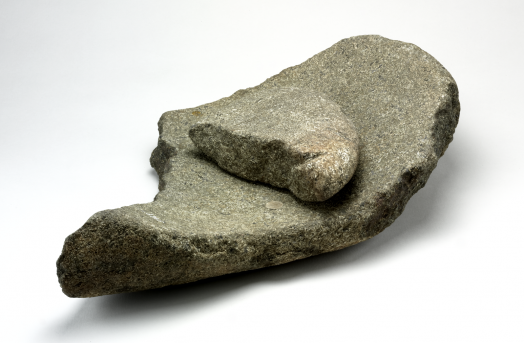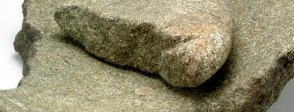
The invention and spread of agriculture
Farming began in the Middle East, China, India and South East Asia about 10,000 years ago. It spread slowly across Europe from the area around Syria and Iraq when, from about 7000 BC, people started moving west and east, taking their crops, animals and ideas with them. By about 6000 BC agriculture had reached the North European Plain, which is now the area of Germany and Poland.
By that time, sea levels had risen, flooding what had been dry land during the Ice Age and turning Britain into an island. For a further two thousand years, Britain’s population carried on their hunting and gathering lifestyle, but around 4000 BC farming was adopted here with plants and animals being brought from mainland Europe by boat.
Neolithic plants and animals
The earliest crops that were grown include types of wheat known as emmer and einkorn, different varieties of barley, and possibly rye. To get at the flour within, the tough husk of these grains needed to be crushed. Saddle querns, so-called because they have the shape of a saddle from above, were used to do this. The concave depression in the stone was created by many hours of work with a convex rubbing stone.
The earliest domesticated animals introduced from the continent include sheep, goats, cows and pigs, though Britain’s own wild pigs may also have been domesticated. Dogs had already been domesticated in the Mesolithic period.
Settling down
The adoption of agriculture, especially crop-growing, encouraged communities to stay in one place. Trees were felled with stone axes, the earth exposed with antler picks and wooden or bone spades, and then lightly tilled with a wooden plough. Crops were harvested with flint sickles. Members of the community who tended animals may still have moved around, but communal meeting places brought people together at certain times of the year to feast and exchange.
Along with growing crops and keeping animals, pottery manufacture was taken up enthusiastically in Britain. Pots are not easy to carry round and suggest people settled in a home and archaeologists are finding larger numbers of Neolithic fields and houses. It was in the stone foundations of a circular house that this well-worn saddle quern was found.
More information
Using a quern
A saddle quern from Syria with useful information about its use.
http://www.britishmuseum.org/explore/highlights/highlight_objects/pe/q/quern_stone_for_making_flour.aspx
Adoption of farming
BBC History pages about the invention and adoption of farming.
http://www.bbc.co.uk/history/ancient/british_prehistory/overview_british_prehistory_01.shtml
Stone Age life
BBC History pages on Stonehenge and Stone Age life.
http://www.bbc.co.uk/history/ancient/british_prehistory/stonehenge_stoneage.shtml#three
A History of the World in 100 Objects
A History of the World in 100 Objects: a Neolithic jadeite axe. Listen to the radio programme or read the transcript.
http://www.bbc.co.uk/ahistoryoftheworld/objects/ZRfYPmVMSgmqZyFEY8VRJA
Time Team
A Time Team video comparing the effectiveness of a Mesolithic and a Neolithic axe.
https://www.youtube.com/watch?v=sT99CvsSt1Q
More information
-
Using a quern
A saddle quern from Syria with useful information about its use.
Source: britishmuseum.org
-
Adoption of farming
BBC History pages about the invention and adoption of farming.
Source: bbc.co.uk
-
Stone Age life
BBC History pages on Stonehenge and Stone Age life.
Source: bbc.co.uk
-
A History of the World in 100 Objects
A History of the World in 100 Objects: a Neolithic jadeite axe. Listen to the radio programme or read the transcript.
Source: bbc.co.uk
-
Time Team
A Time Team video comparing the effectiveness of a Mesolithic and a Neolithic axe.
Source: youtube.com


